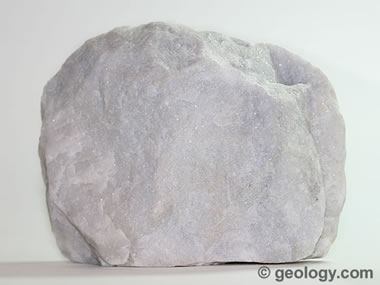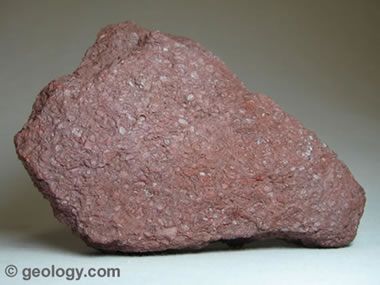Home » Rocks » Sedimentary Rocks
Pictures of Sedimentary Rocks
Photos of Common Clastic, Chemical, and Organic Sedimentary Rock Types.
Article by: Hobart M. King, PhD, RPG
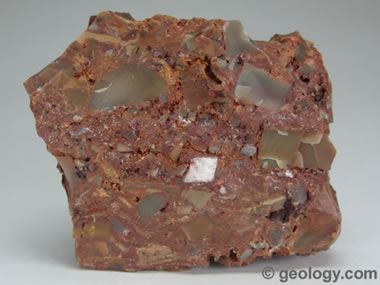
Breccia is a clastic sedimentary rock that is composed of large (over two-millimeter diameter) angular fragments. The spaces between the large fragments can be filled with a matrix of smaller particles or a mineral cement which binds the rock together. The specimen shown above is about two inches (five centimeters) across.
What Are Sedimentary Rocks?
Sedimentary rocks are formed by the accumulation of sediments. There are three basic types of sedimentary rocks.
Clastic sedimentary rocks form from the accumulation and lithification of mechanical weathering debris. Examples include: breccia, conglomerate, sandstone, siltstone, and shale.
Chemical sedimentary rocks form when dissolved materials preciptate from solution. Examples include: chert, some dolomites, flint, iron ore, limestones, and rock salt.
Organic sedimentary rocks form from the accumulation of plant or animal debris. Examples include: chalk, coal, diatomite, some dolomites, and some limestones.
Photos and brief descriptions of some common sedimentary rock types are shown on this page.
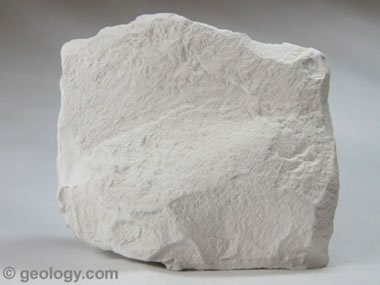
Chalk is a type of limestone made up of the microscopic calcium carbonate shells of marine organisms. Chalk is soft, friable, porous, and effervesces vigorously in contact with hydrochloric acid. Because it is very porous, subsurface chalk units can serve as reservoirs for oil and natural gas.
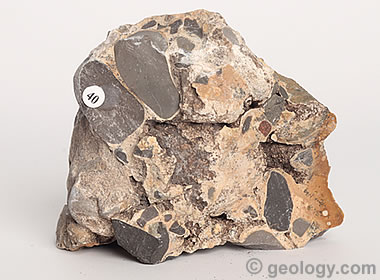
Caliche is found in arid or semiarid climates around the world. It forms when rock fragments and sediment particles are cemented together by mineral matter, usually calcium carbonate, that precipitates and hardens between the particles. Over time, caliche can become very dense and durable, which explains why it is also called hardpan, calcrete, and duricrust. Some people might call it a puddingstone.
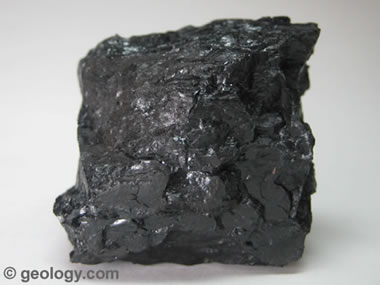
Coal is an organic sedimentary rock that forms mainly from plant debris. The plant debris usually accumulates in a swamp environment. Coal is combustible and is often mined for use as a fuel. The specimen shown above is about two inches (five centimeters) across.
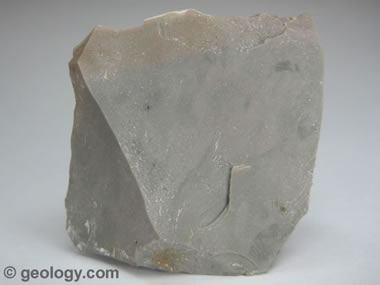
Chert is a microcrystalline or cryptocrystalline sedimentary rock material composed of silicon dioxide (SiO2). It occurs as nodules and concretionary masses, and less frequently as a layered deposit. It breaks with a conchoidal fracture, often producing very sharp edges. Early people took advantage of how chert breaks and used it to fashion cutting tools and weapons. The specimen shown above is about two inches (five centimeters) across.
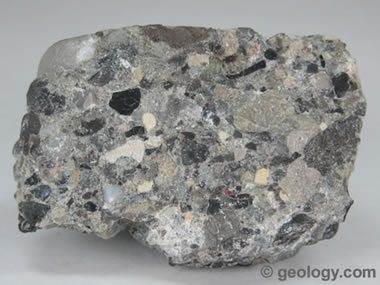
Conglomerate is a clastic sedimentary rock that contains large (greater than two millimeters in diameter) rounded particles. The space between the pebbles is generally filled with smaller particles and/or a chemical cement that binds the rock together. The specimen shown above is about two inches (five centimeters) across.
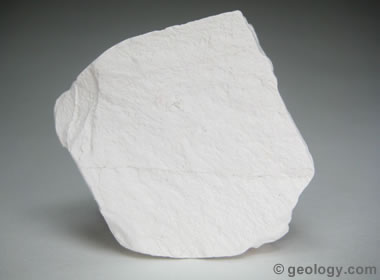
Diatomite is a sedimentary rock with many uses. It is made up of the siliceous skeletal remains of diatoms, which are tiny single-celled algae. Diatomite is crushed into a powder known as "diatomaceous earth". It is lightweight, porous, relatively inert, and has a small particle size along with a large surface area. These properties make diatomaceous earth useful as a filtration media, a lightweight aggregate, a lightweight filler, an effective absorbent, and more.
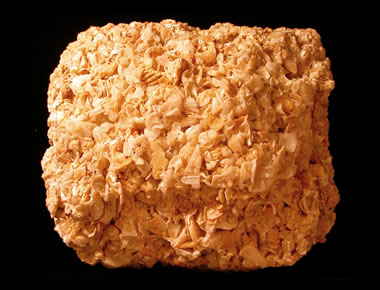
Coquina is a type of limestone composed of calcium carbonate shells, shell fragments, and other sand-sized fossil debris. It forms in the shallow waters of coastal areas with a tropical or subtropical climate. The particles are weakly cemented together, and therefore coquina is a very porous material that can function as an aquifer or a reservoir for oil and natural gas. Public Domain photo by Mark A. Wilson of the Department of Geology, The College of Wooster.
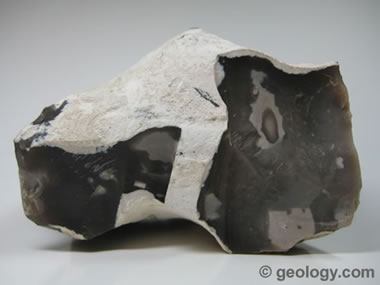
Flint is a hard, tough, chemical or biochemical sedimentary rock that breaks with a conchoidal fracture. It is a form of microcrystalline quartz that is typically called “chert” by geologists. It often forms as nodules in sedimentary rocks such as chalk and marine limestones.

Limestone is a rock that is composed primarily of calcium carbonate. It can form organically from the accumulation of shell, coral, algal, and fecal debris. It can also form chemically from the precipitation of calcium carbonate from lake or ocean water. Limestone is used in many ways. Some of the most common are: production of cement, crushed stone, and acid neutralization. The specimen shown above is about two inches (five centimeters) across.
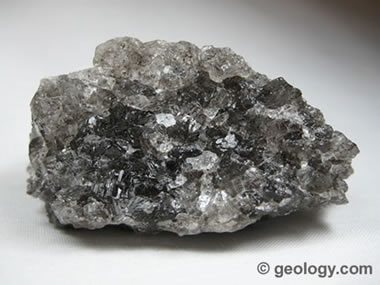
Rock Salt is a chemical sedimentary rock that forms from the evaporation of ocean or saline lake waters. It is also known by the mineral name "halite." It is rarely found at Earth's surface, except in areas of very arid climate. It is often mined for use in the chemical industry or for use as a winter highway treatment. Some halite is processed for use as a seasoning for food. The specimen shown above is about two inches (five centimeters) across.

Oil Shale is a rock that contains significant amounts of organic material in the form of kerogen. Up to 1/3 of the rock can be solid organic material. Liquid and gaseous hydrocarbons can be extracted from the oil shale, but the rock must be heated and/or treated with solvents. This is usually much less efficient than drilling rocks that will yield oil or gas directly into a well. The processes used for hydrocarbon extraction also produce emissions and waste products that cause significant environmental concerns.

Shale is a clastic sedimentary rock that is made up of clay-size (less than 1/256 millimeter in diameter) weathering debris. It typically breaks into thin flat pieces. The specimen shown above is about two inches (five centimeters) across.
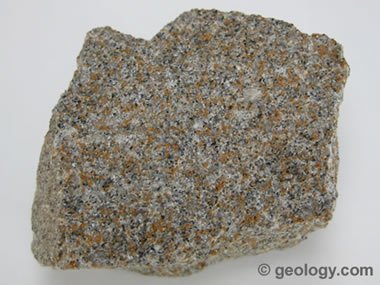
Sandstone is a clastic sedimentary rock made up mainly of sand-size (1/16 to 2 millimeter diameter) weathering debris. Environments where large amounts of sand can accumulate include beaches, deserts, flood plains, and deltas. The specimen shown above is about two inches (five centimeters) across.
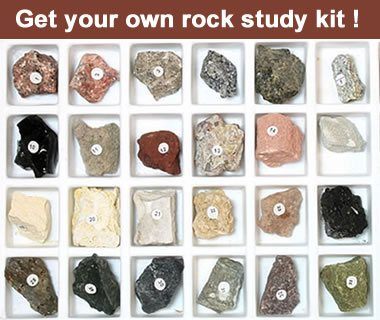
The best way to learn about rocks is to have a collection of specimens to examine while you study. Seeing and handling the rocks will help you understand their composition and texture much better than reading about them on a website or in a book. The Geology.com store offers inexpensive rock collections that can be mailed anywhere in the United States or U.S. Territories. Mineral collections and instructive books are also available.
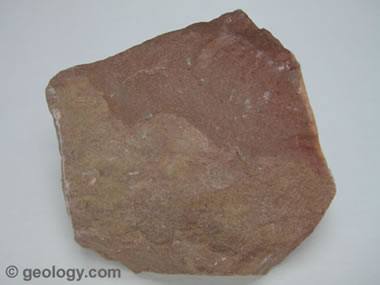
Siltstone is a clastic sedimentary rock that forms from silt-size (between 1/256 and 1/16 millimeter diameter) weathering debris. The specimen in the photo is about two inches (five centimeters) across.
| More Rocks |
 |
Gifts That Rock |
 |
The Rock Used to Make Beer |
 |
Geodes |
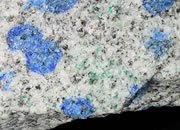 |
Azurite Granite? |
 |
Tumbled Stones |
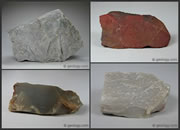 |
Flint, Chert, and Jasper |
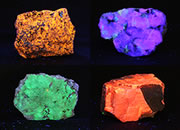 |
Fluorescent Minerals |
 |
Fossils |

Find Other Topics on Geology.com:

|

| ||

|

| ||

|

| ||

|

|

